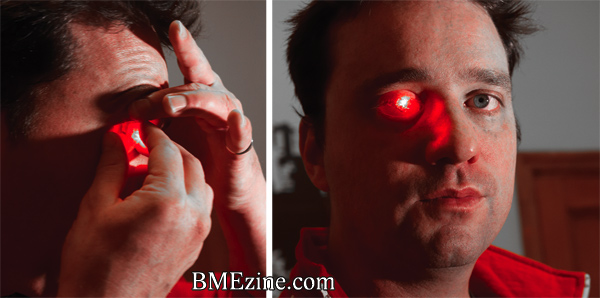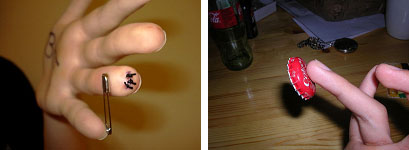 Body modification, a growing practice and subculture that now spans the world, has made extensive gains in merging the body with technology. Stretched earlobes, facial tattooing, and dermal implants have become more conspicuous as of late in many urban locales, and it is no longer surprising to find people going to greater lengths to modify their bodies in sometimes unique and shocking ways. For more examples, spend some time on one of the most popular online body modification community websites, Body Modification Ezine.com. The site documents the diverse array of practices that members engage in to explore, test, stretch, and construct their bodies in new ways. (Warning: The content is not for the squeamish).
Body modification, a growing practice and subculture that now spans the world, has made extensive gains in merging the body with technology. Stretched earlobes, facial tattooing, and dermal implants have become more conspicuous as of late in many urban locales, and it is no longer surprising to find people going to greater lengths to modify their bodies in sometimes unique and shocking ways. For more examples, spend some time on one of the most popular online body modification community websites, Body Modification Ezine.com. The site documents the diverse array of practices that members engage in to explore, test, stretch, and construct their bodies in new ways. (Warning: The content is not for the squeamish).
Particularly, I want to focus in on a few keen examples of the merging of body and technology, or as I call it, the new cyborg body.
 First off is the now infamous Rob Spence, a man who successfully implanted a LED light into the cavity of his lost eye. He is something of a legend in the body modification community, mostly because of his unique situation and how he turned to body modification to make the most of it. He lost his eye as a teen and then, several years ago, got this red LED light implanted into the empty cavity. He is currently working to construct the world’s first miniature prosthetic eye camera to replace the current LED light. Arguably, Rob Spence epitomizes of Donna Haraway’s concept of the cyborg—the merging of organism and technology. No longer metaphorical, we now have true cyborgs among us!
First off is the now infamous Rob Spence, a man who successfully implanted a LED light into the cavity of his lost eye. He is something of a legend in the body modification community, mostly because of his unique situation and how he turned to body modification to make the most of it. He lost his eye as a teen and then, several years ago, got this red LED light implanted into the empty cavity. He is currently working to construct the world’s first miniature prosthetic eye camera to replace the current LED light. Arguably, Rob Spence epitomizes of Donna Haraway’s concept of the cyborg—the merging of organism and technology. No longer metaphorical, we now have true cyborgs among us!
In another interesting convergence of body and technology, an increasingly popular trend in the body modification community is to get magnets implanted in your fingertips. These tiny, powerful neodymium magnets are implanted under the skin and allow the individual to pick up small things like nails, paperclips, screws and washers. You can find several blog posts about them on BME.com, as well as several YouTube videos of individuals playing with their finger magnets.
I would argue that body modification, rather than a marginal activity reserved for social deviants, is something that is becoming increasingly relevant to our understandings of the body. Though the origins of body modification lie in urban subcultures, they are becoming increasingly normative for younger generations (think of how many people you know under the age of 25 that have at least some piercings or a tattoo). The body has become the latest terrain for identity construction, as individuals seek to display their individuality and tastes through modification. In addition, body modification is challenging the very notions of the body as an ontological whole and changing how we display and pursue our very selves. No longer is the “body as temple” (as Judeo-Christian belief contends) something that must remain untouched, but something that must be adorned to show our respect and admiration for ourselves. In this sense, body modification serves as but another manifestation of the body projects that contemporary society enforces upon us. In Foucault’s terms, we show our sociality by “disciplining” ourselves in lines with societal standards (think of dieting and exercise as a measure of social competence). And body modification, as a unique form of discipline, is pushing these norms in new directions.
I will be back to share more examples of human-machine interaction in the body modification community. Until next time, here is a list of resources for further reading: Mike Featherstone has written extensively on how the body is now the site of identity construction in late-consumer society; Victoria Pitts has written on the body projects of marginalized groups (LGBT communities and women, specifically) as an effort to resist patriarchal and Judeo-Christian domination; and Gill and Mclean have written on the body projects of men as a form of constructing, negotiating, and policing hegemonic masculinity in contemporary society

Comments 4
PJ Patella-Rey — November 16, 2010
Interesting post! I am curious whether certain categories of body modification have, or will become, "normal" and what categories of body modification are likely to remain marginal. For example, tattooing is very popular among young adults. It offers a permanent revision of one's appearance, presumably for aesthetic reasons. It strikes me, however, that a person gains little from having magnets implanted into their hand relative to simply holding a magnet in their hand. Why do it? It it likely to become popular? Finally, I assume these surgeries are amateur jobs. Will part of the normalization process be to professionalize such procedures?
Travis Hall — November 23, 2010
Love the topic, and am very interested in the post- but I'd like to problematize the idea that the Judeo-Christian tradition is anti-body modification. While this may be true of its more recent iterations, the use of tattoos as both a means of identifying with the suffering of Christ and an association with the slaves of Rome was common among particular sects of early Christians (see relevant chapters in Jane Caplan's Written on the Body: the Tattoo in European and American History). Jews have historically been less approving of body modification stems primarily from particular readings of Leviticus 19:28 ("You shall not make gashes in your flesh for the dead, or incise any marks on yourselves: I am the Lord"), but as with most biblical hermeneutic the actual implications are fuzzy and open to debate. The urban legend that Jews cannot be buried with tattoos is just that- an urban legend.
The (New) Cyborg Body Revisited: The Eyeborg Documentary » Cyborgology — October 13, 2011
[...] Rob Spence, the human cyborg (or Eyeborg as he prefers to call himself). I have written about him once before on this blog, and he has been a documenting his technological cyborg transformation extensively through video [...]
Origins of the Augmented Subject » Cyborgology — January 15, 2013
[...] Your hand is a part of “you,” but what if you had a prosthetic hand? Are your tattoos, piercings, braces, implants, or other modifications part of “you”? What about your Twitter feed, or your [...]